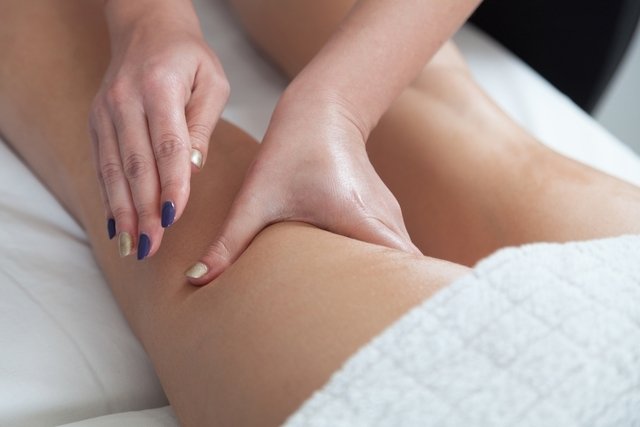Some ways to end fluid retention and reduce swelling are to increase water consumption and diuretic teas, perform lymphatic drainage and practice physical activity. However, some kidney, heart or liver diseases can cause fluid retention, and the doctor recommends the use of diuretic medications in these situations.
Fluid retention, also called edema, is when a part of the body becomes more swollen due to the accumulation of fluids inside the cells, which can happen when you stay in the same position for a long time, a sedentary lifestyle, hormonal changes, a diet rich in sodium or being consequence of diseases. See more about fluid retention.
The accumulation of fluids in the body causes swelling, which can be noticed by the increase in volume in the belly, face and, especially, the legs, ankles and feet. Pressing with your thumb for 30 seconds on the area close to your ankles and then observing whether the area is marked is an easy way to discover that you are retaining fluids. The mark on the sock on the ankle or the mark on tight clothing around the waist also serves to assess whether the person has fluid retention.

How to get rid of fluid retention
Some main ways to end fluid retention and debloat include:
1. Take diuretic teas
Diuretic teas are an excellent complement to help you lose weight faster, and the best options are:
- Horsetail,
- Hibiscus;
- Cinnamon with ginger;
- Green Tea;
- Ginkgo biloba;
- Parsley;
- Asian spark;
- Horse chestnut.
Any tea has a diuretic effect, because basically the more water you consume, the more urine is produced. However, certain plants increase this diuretic effect of teas, such as green tea, horsetail, hibiscus, ginger and parsley. Check out other diuretic tea options.
2. Do physical exercise
Doing physical exercise is also an excellent natural way to quickly deflate your body, contributing to weight loss. The contraction of muscle groups such as arms, legs and glutes forces excess fluids to be eliminated through urine. Therefore, it is common to feel the urge to urinate after 1 hour of exercise at the gym.
Some exercises that may be recommended are brisk walking, running, cycling with heavy gears to put greater effort on the legs and jumping rope, for example. Localized exercises are not as beneficial as these, but they can be an option, after about 20 minutes of aerobic activity, for example.
3. Food care
It is important to take some precautions with your diet to reduce fluid retention, the main ones being:
- Drink waterabout 2 liters per day, or teas, such as horsetail and hibiscus tea;
- Replace the salt with aromatic herbs, such as parsley, thyme or oregano, for example;
- Increase consumption of diuretic foodssuch as watermelon, cucumber, pear and melon;
- Avoid canned foodssausages or others with a lot of salt;
- Eat foods rich in watersuch as radish, turnip, cauliflower, watermelon, strawberry, pineapple, apple or carrot;
- Increase consumption of foods rich in potassiumsuch as cooked beetroot leaves, lentils, avocado, low-fat yogurt and banana.
Squeezing 1 lemon into 1 liter of water and drinking it throughout the day, without sugar, is also an excellent strategy for debloating faster, which quickly reduces abdominal volume.
Check out the following video for some tips on how to eat to reduce fluid retention:
4. Perform lymphatic drainage
Lymphatic drainage is a great strategy for eliminating excess fluid from the body, which can be done manually, through a gentle massage with well-marked movements, but it can also be performed with electronic equipment designed for mechanical lymphatic drainage, called pressotherapy. . See how manual lymphatic drainage can be done.
These treatments can be carried out in specialized aesthetic clinics, with sessions ranging from 3 to 5 times a week, depending on each person’s needs. Each session lasts 45 to 60 minutes and immediately afterwards the person should feel the need to urinate, which indicates that the treatment had the expected effect. Lymphatic drainage is a good complement to cellulite treatment, being recommended after treatments such as radiofrequency and lipocavitation, for example.
5. Taking diuretic medications
In the treatment for fluid retention, the use of diuretic medications, such as Furosemide, Hydrochlorothiazide or Aldactone, may also be recommended by the doctor. Check out other diuretic medications that your doctor may recommend.
Read too: 6 remedies for fluid retention (and natural options)
Fluid retention during pregnancy
Swelling is normal during pregnancy due to the hormonal changes that occur at this stage and occurs mainly in the 2nd and end of the 3rd trimester of pregnancy, which is when the woman may feel more tired and less willing to walk or exercise.
What to do: Wearing elastic stockings on your legs and feet is an excellent strategy, but they should be put on before getting out of bed. Pregnant women should also reduce their intake of salt and processed products, rich in sodium, and drink plenty of water and teas approved by their obstetrician. Walking for 30 minutes to 1 hour every day and exercising regularly also help reduce fluid retention during this period.
Bibliography
- PUJOL, AP Nutrition applied to aesthetics. Rio de Janeiro: Rubio, 2011.
- MCINTYRE, A. Complete guide to herbal medicine. São Paulo: Pensamento, 2011.
- LEDUC, Albert; LEDUC, Olivier.. Lymphatic Drainage: Theory and practice. 3rd edition. São Paulo: Manole, 2007.
- SANTANA, Juan Carlos. Functional Training: exercise program for training and performance. 1.ed. São Paulo: Manole, 2017.
- HARVARD HEALTH PUBLISHING. Fluid retention: What it can mean for your heart. 2014. Disponível em: <https://www.health.harvard.edu/heart-health/fluid-retention-what-it-can-mean-for-your-heart>. Acesso em 16 abr 2019
- HEALTHDIRECT AUSTRALIA. Fluid retention. 2018. Available at: <https://www.healthdirect.gov.au/fluid-retention>. Accessed on April 16, 2019

Sign up for our newsletter and stay up to date with exclusive news
that can transform your routine!
Warning: Undefined array key "title" in /home/storelat/public_html/wp-content/plugins/link-whisper-premium/templates/frontend/related-posts.php on line 12
Warning: Undefined array key "title_tag" in /home/storelat/public_html/wp-content/plugins/link-whisper-premium/templates/frontend/related-posts.php on line 13




